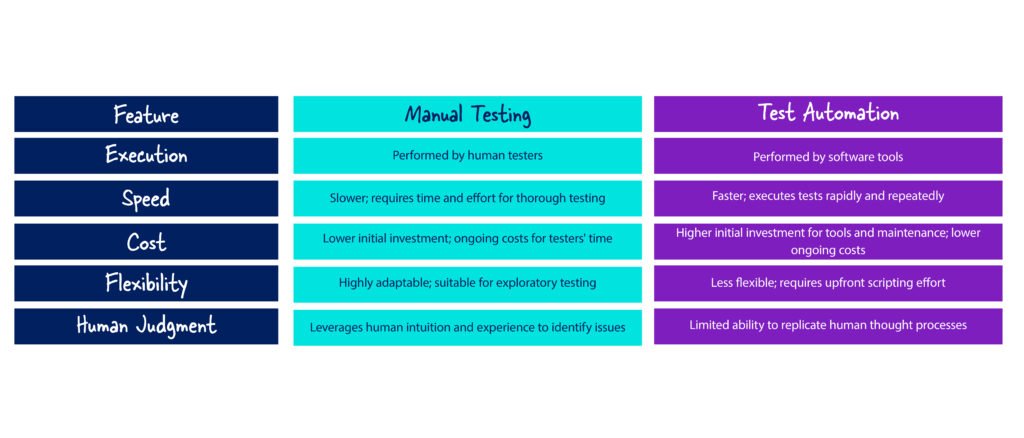July 2, 2024

Software Development Outsourcing
Manual Testing vs Automation: Choosing the Right Path for Your QA Strategy
Manual Testing vs Automation: ensuring software quality remains paramount. This is where the debate around manual testing vs automation comes into play.
Both approaches offer distinct advantages and cater to specific scenarios within the Quality Assurance (QA) process.

This blog post dives deep into the ongoing conversation of manual testing vs automation. We’ll explore the strengths and weaknesses of each approach, analyze their effectiveness through compelling statistics.
Understanding the Landscape: Manual Testing vs Automation
Manual testing involves human testers meticulously interacting with the software to identify bugs and ensure functionality.
It offers a comprehensive approach, allowing testers to leverage their creativity, critical thinking, and domain expertise to uncover issues that might evade automation.
Test automation, on the other hand, utilizes software tools to automate the execution of test cases. This approach excels at repetitive tasks, regression testing, and achieving faster test execution cycles.
Here’s a table summarizing the key differences between manual testing vs automation:

Manual testing vs automation is not an either/or proposition. They are complementary approaches that, when combined strategically, create a robust QA process.
Let’s delve deeper into the advantages and disadvantages of each approach to guide your decision-making process.
The Power of Human Ingenuity: Advantages of Manual Testing
Manual testing offers several key advantages that make it a valuable asset in your QA strategy:
Exploratory Testing: Manual testers excel at exploratory testing, where they can freely explore the software and identify unforeseen issues through creative thinking.
Usability Testing: Evaluating user experience and user interface (UI) design is often best achieved through manual testing, allowing testers to assess user behavior and interactions.
Edge Case Testing: Testing software under unusual or extreme conditions is often more effectively conducted through manual testing, ensuring the software remains robust in unexpected scenarios.
Domain Expertise: In specific industries, manual testers with domain expertise can leverage their knowledge to identify issues that might be missed by automated tests.
Manual testing provides a human touch to the QA process, ensuring software caters to user needs and delivers a positive user experience.
Efficiency and Speed: Advantages of Test Automation
Test automation offers distinct benefits that streamline your QA process:
Increased Efficiency: Automation allows for faster execution of repetitive test cases, freeing up testers’ time for more strategic tasks.
Improved Regression Testing: Automated regression testing ensures previously fixed bugs don’t resurface in new code versions, saving time and resources.
Enhanced Scalability: Test automation scales efficiently, allowing you to execute a larger volume of tests with minimal additional effort.
Reduced Human Error: Automated tests are executed consistently and precisely, eliminating the risk of human error that can occur during manual testing.
Test automation helps you achieve faster testing cycles and improve the overall efficiency of your QA process.
Making an Informed Decision: Choosing the Right Approach for Your Needs
Manual testing vs automation – the optimal approach depends on your specific project requirements. Consider these factors when making your decision:
Project Complexity: For highly complex software, a combination of manual testing and test automation might be necessary.
Test Case Repetitiveness: If your testing process involves a high volume of repetitive tasks, test automation is a strong candidate.
Project Budget: Manual testing typically requires a lower initial investment, while test automation has higher upfront costs for tools and maintenance.
Testing Time Constraints: If you have tight deadlines, test automation can accelerate your testing cycles.
Availability of Testers: If your QA team is limited in size, test automation can help manage the testing workload.
By carefully evaluating your project requirements and resources, you can select the most effective approach for your manual testing vs automation strategy.
The Future of QA: A Collaborative Approach
Manual testing vs automation need not be a competition. The future of QA lies in a collaborative approach that leverages the strengths of both methodologies. Here’s how you can achieve this synergy:
Focus on Automation for Repetitive Tasks: Utilize test automation to handle repetitive regression testing and free up your manual testers for more complex tasks.
Combine Automation with Exploratory Testing: Employ manual testing for exploratory testing, allowing testers to identify unforeseen issues that automation might miss.
Leverage Testers’ Expertise for Automation Development: Involve your manual testers in the test automationprocess. Their domain knowledge can be invaluable for creating effective test scripts.
Invest in the Right Tools: Choose test automation tools that are user-friendly and integrate seamlessly with your existing development workflow.
By fostering a collaborative environment where manual testing and test automation work hand-in-hand, you can create a robust and efficient QA strategy.
Conclusion: Building a Successful QA Strategy
The debate around manual testing vs automation isn’t about a single best approach. It’s about understanding the strengths and weaknesses of each methodology and strategically combining them to meet your specific project needs.
Here’s a quick recap to guide your QA strategy development:
- Clearly define your project requirements and limitations.
- Identify areas where automation can streamline repetitive tasks.
- Recognize the importance of manual testing for user experience and exploratory testing.
- Invest in building a collaborative QA team with expertise in both manual and automated testing.
- Continuously evaluate and adapt your QA strategy as your project evolves.
By embracing a comprehensive approach that leverages both manual testing and test automation, you can ensure high-quality software that meets user expectations and delivers long-term value. Remember, a well-defined QA strategy is an investment in the success of your software development projects.
Ready to take the next step? Book a meeting now with our team and explore how we can become your ideal strategic partner to fill your testing needs. Together, let’s turn your vision into a reality.
Learn more about Nearshore Staff augmentation Latin America in 2024 here









